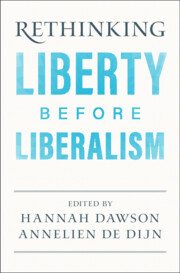Book contents
- Rethinking Liberty before Liberalism
- Rethinking Liberty before Liberalism
- Copyright page
- Dedication
- Contents
- Figures
- Contributors
- Acknowledgements
- Introduction
- Part I Authors
- Part II Hierarchies
- 4 Liberty and Hierarchy in Milton’s Revolutionary Prose
- 5 Democratic Republicanism in the Early Modern Period
- 6 Gender, Liberty, Participation, and Virtue
- 7 Liberty, Death, and Slavery in the Age of Atlantic Revolutions, 1770s–1790s
- Part III Traditions
- Conclusion
- Bibliography
- Index
6 - Gender, Liberty, Participation, and Virtue
What the Eighteenth Century Can Teach Us about Republicanism
from Part II - Hierarchies
Published online by Cambridge University Press: 22 February 2022
- Rethinking Liberty before Liberalism
- Rethinking Liberty before Liberalism
- Copyright page
- Dedication
- Contents
- Figures
- Contributors
- Acknowledgements
- Introduction
- Part I Authors
- Part II Hierarchies
- 4 Liberty and Hierarchy in Milton’s Revolutionary Prose
- 5 Democratic Republicanism in the Early Modern Period
- 6 Gender, Liberty, Participation, and Virtue
- 7 Liberty, Death, and Slavery in the Age of Atlantic Revolutions, 1770s–1790s
- Part III Traditions
- Conclusion
- Bibliography
- Index
Summary
Quentin Skinner's neo-Romanism has proved a hugely rich resource for understanding the thought of women philosophers. So why do they not form part of his discussion in Liberty before Liberalism? I argue that this is partly a consequence of Skinner's focus on the sixteenth and seventeenth centuries, when women political philosophers were apparently fewer. When we look at the eighteenth century, particularly at its second half, with the sort of attention to contextual detail Skinner recommends, we find a number of women philosophers embracing and developing a republicanism which emphasizes liberty as non-domination. These women aligned themselves with the tradition of neo-Roman political thought and therefore ought to be studied with equal care. Moreover, a study of their works reveals neo-Roman republicanism in a different light from that of their predecessors, one which takes their position as women in society – as mothers, but also as potential citizens and policy makers - as central. I focus on two authors in particular:Olympe de Gouges and Manon Roland.
Keywords
- Type
- Chapter
- Information
- Rethinking Liberty before Liberalism , pp. 117 - 133Publisher: Cambridge University PressPrint publication year: 2022

